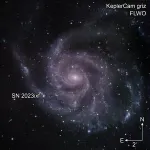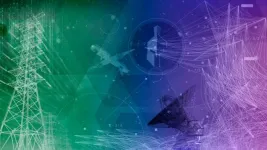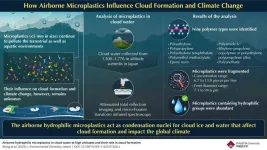(Press-News.org) Because figuring out what is new and what is familiar in what we see is such a critically important ability for prioritizing our attention, neuroscientists have spent decades trying to figure out how our brains are typically so good at it. Along the way they’ve made key observations that seem outright contradictory, but a new study shows that the mystifying measures are really two sides of the same coin, paving the way for a long-sought understanding of “visual recognition memory” (VRM).
VRM is the ability to quickly recognize the familiar things in scenes, which can then be de-prioritized so that we can focus on the new things that might be more important in a given moment. Imagine you walk into your home office one evening to respond to an urgent, late email. There you see all the usual furniture and equipment—and a burglar. VRM helps ensure that you’d focus on the burglar, not your book shelves or your desk lamp.
“Yet we do not yet have a clear picture of how this foundational form of learning is implemented within the mammalian brain,” wrote Picower Professor Mark Bear and fellow authors of the new study in the Journal of Neuroscience.
As far back as 1991 researchers found that when animals viewed something familiar, neurons in cortex, or outer layer of their brain, would be less activated than if they saw something new (two of that study’s authors later became Bear’s colleagues at MIT, Picower Professor Earl K. Miller and Doris and Don Berkey Professor Bob Desimone). But in 2003, Bear’s lab happened to observe the opposite: Mice would actually show a sharp jump in neural activity in the primary visual region of the cortex when a familiar stimulus was flashed in front of the animal. This spike of activity is called a “visually evoked potential” (VEP), and Bear’s lab has since shown that increases in the VEPs are solid indicators of VRM.
The findings in the new study, led by former Bear Lab postdocs Dustin Hayden and Peter Finnie, explain how VEPs increase even amid an overall decline in neural response to familiar stimuli (as seen by Miller and Desimone), Bear said. They also explain more about the mechanisms underlying VRM – the momentary increase of a VEP may be excitation that recruits inhibition, thereby suppressing activity overall.
New understanding
Bear’s lab evokes VEPs by showing mice a black-and-white striped grating in which the stripes periodically switch their shade so that the pattern appears to reverse. Over several days as mice view this stimulus pattern, the VEPs increase, a reliable correlate of the mice becoming familiar with—and less interested in—the pattern. For 20 years Bear’s lab has been investigating how the synapses involved in VRM change by studying a phenomenon they’ve dubbed “stimulus-selective response plasticity” (SRP).
Early studies had suggested that SRP occurs among excitatory neurons in layer 4 of the visual cortex and specifically might require the molecular activation of their NMDA receptors. The lab had seen that knocking out the receptors across the visual cortex prevented the increase in VEPs and therefore SRP, but a follow-up in 2019 found that knocking them out just in layer 4 had no effect. So, in the new study they decided to study VEPs, SRP and VRM across the whole visual cortex, layer by layer, in search of how it all works.
What they found was that many of the hallmarks of VRM, including VEPs, occur in all layers of the cortex but that it seemed to depend on NMDA receptors on a population of excitatory neurons in layer 6, not layer 4. This is an intriguing finding, the authors said, because those neurons are well connected to the thalamus (a deeper brain region that relays sensory information) and to inhibitory neurons in layer 4, where they had first measured VEPs. They also measured changes in brain waves in each layer that confirmed a previous finding that when the stimulus pattern is new, the prevailing brain wave oscillations are in a higher “gamma” frequency that depends on one kind of inhibitory neuron, but as it becomes more familiar, the oscillations shift toward a lower “beta” frequency that depends on a different inhibitory population.
A short spike amid a long lull
The team’s rigorous and precise electrophysiology recordings of neural electrical activity in the different layers also revealed a potential resolution to the contradiction between VEPs and the measures of labs like that of Miller and Desimone.
“What this paper reveals is that everybody is right,” Bear quipped.
How so? The new data show that VEPs are very pronounced but transient spikes of neural electrical activity that occur amid a broader, overall lull of activity. Previous studies have reflected only the overall decrease because they have not had the temporal resolution to detect the brief spike. Bear’s team, meanwhile, has seen the VEPs for years but didn’t necessarily focus on the surrounding lull.
The new evidence suggests that what’s happening is that the VEP is a sign of the activity of the brain quickly recognizing a familiar stimulus and then triggering an inhibition of activity related to it.
“What I think is exciting about this is that it suddenly sheds light on the mechanism, because it’s not that the encoding of familiarity is explained by the depression of excitatory synapses,” Bear said. “Rather, it seems to be accounted for by the potentiation of excitatory synapses on to neurons that then recruit inhibition in the cortex.”
Even as it advances that understanding of how VRM arises, the study still leaves open questions including the exact circuits involved. For instance, the exact contribution of the layer 6 circuit neurons is not yet clear, Bear said. And so, the quest goes on.
In addition to Hayden, Finnie and Bear, the paper’s other authors are Aurore Thomazeau, Alyssa Li and Samuel Cooke.
The National Eye Institute of the National Institutes of Health, The Picower Institute for Learning and Memory and The JPB Foundation funded the study.
END
Resolving a seeming contradiction, study advances understanding of visual recognition memory
2023-09-27
ELSE PRESS RELEASES FROM THIS DATE:
The Buck Institute and Phenome Health announce major strategic partnership
2023-09-27
The Buck Institute for Research on Aging and Phenome Health are joining forces in the quest to understand the biology of aging. Phenome Health, a Seattle-based nonprofit research organization led by CEO Lee Hood, MD, PhD, uses a data-driven approach to health and disease that integrates diverse types of biological big data. The new Center for Phenomic Health at the Buck will be co-led by Dr. Hood, who joins the Buck as Chief Innovation Officer and Distinguished Professor, and Eric Verdin, MD, Buck President ...
Revolutionary breakthrough: human stomach micro-physiological system unveiled
2023-09-27
A groundbreaking development in biomedical engineering has led to the creation of a human stomach micro-physiological system (hsMPS), representing a significant leap forward in understanding and treating various gastrointestinal diseases, including stomach cancer. The research team, led by Professor Tae-Eun Park from the Department of Biomedical Engineering at UNIST and Professor Seong-Ho Kong from Seoul National University Hospital, has successfully developed a biomimetic chip that combines organoid and organ-on-a-chip technologies to simulate the complex defense mechanisms of the human gastric mucosa.
Organoids, which mimic human organs using stem cells, have ...
ORNL launches Center for AI Security Research to study AI’s impacts on society, security
2023-09-27
The Department of Energy’s Oak Ridge National Laboratory announced the establishment of its Center for AI Security Research, or CAISER, to address threats already present as governments and industries around the world adopt artificial intelligence and take advantage of the benefits it promises in data processing, operational efficiencies and decision-making.
In partnership with federal agencies such as the Air Force Research Laboratory’s Information Directorate and the Department of Homeland Security (DHS) Science and Technology Directorate ...
Extreme weight loss: Star sheds unexpected amounts of mass just before going supernova
2023-09-27
Cambridge, Mass. — A newly discovered nearby supernova whose star ejected up to a full solar mass of material in the year prior to its explosion is challenging the standard theory of stellar evolution. The new observations are giving astronomers insight into what happens in the final year prior to a star’s death and explosion.
SN 2023ixf is a new Type II supernova discovered in May 2023 by amateur astronomer Kōichi Itagaki of Yamagata, Japan shortly after its progenitor, or origin star, ...
Target: BP™ intitiative helps more than 8.6 million Americans with hypertension improve heart health
2023-09-27
DALLAS, September 27, 2023 — The American Heart Association and American Medical Association (AMA) nationally recognized 1,709 health care organizations (HCOs) — 400 more than in 2022 — for their efforts to prioritize control of their patients’ blood pressure (BP), a leading preventable risk factor for heart disease, stroke and premature death.
According to the 2022 American Heart Association Statistical Update, nearly half of U.S. adults — 121.5 million ...
Tiny CRISPR tool could help shred viruses
2023-09-27
HOUSTON – (Sept. 27, 2023) Small and precise: These are the ideal characteristics for CRISPR systems, the Nobel-prize winning technology used to edit nucleic acids like RNA and DNA.
Rice University scientists have described in detail the three-dimensional structure of one of the smallest known CRISPR-Cas13 systems used to shred or modify RNA and employed their findings to further engineer the tool to improve its precision. According to a study published in Nature Communications, the molecule works differently than other proteins in the same family.
“There are different types of CRISPR systems, and the one ...
Plastic cloud: New study analyzes airborne microplastics in clouds
2023-09-27
Plastic particles less than 5 mm in size are called “microplastics.” These tiny bits of plastic are often found in industrial effluents, or form from the degradation of bulkier plastic waste. Research shows that large amounts of microplastics are ingested or inhaled by humans and animals alike and have been detected in multiple organs such as lung, heart, blood, placenta, and feces. Ten million tons of these plastic bits end up in the ocean, released with the ocean spray, and find their way into the atmosphere. This implies that microplastics may have become an essential component of clouds, ...
Winners of the ASTRO-Sumitomo Pharma-Pfizer Alliance new combination therapy challenge announced
2023-09-27
ARLINGTON, Va., September 27, 2023 — The American Society for Radiation Oncology (ASTRO) today announced the three winning research proposals for the 2022 ASTRO-Myovant Sciences (now known as Sumitomo Pharma)-Pfizer Alliance New Combination (Relugolix-Radiation) Therapy Challenge. The Challenge aims to identify research that addresses ways prostate cancer treatments can be improved with the gonadotropin-releasing hormone (GnRH) receptor antagonist relugolix in patients who received radiation therapy.
The Challenge invited researchers to propose the study of relugolix in different scenarios: ...
New evidence for sub-network specializations within the Default Mode Network and the Special Role of Facial Movements in Brain Activation and Self-Perception
2023-09-27
Recent advancements in neuroscience have unveiled new insights into the neural processes responsible for self-referential cognition. This research has brought particular attention to a critical neural network known as the Default Mode Network (DMN), comprising brain regions such as the medial prefrontal cortex (mPFC), posterior cingulate cortex, temporoparietal junction (TPJ), and both lateral and medial temporal lobes.
Central to self-related processing, is the information associated with one’s ...
Ultrasound enables gene delivery throughout the brain
2023-09-27
HOUSTON – (Sept. 27, 2023) – Rice University researchers tested the safety and feasibility of gene delivery to multiple brain regions using a noninvasive, ultrasound-based technique in rodents, and their findings suggest that the efficiency of gene delivery improves within each targeted site when more sites are opened.
Shirin Nouraein, a doctoral student working in the lab of Rice bioengineer Jerzy Szablowski, is the lead author on the study recently published in the journal Gene Therapy.
The paper, “Acoustically Targeted Noninvasive Gene Therapy in Large Brain Volumes,” ...









